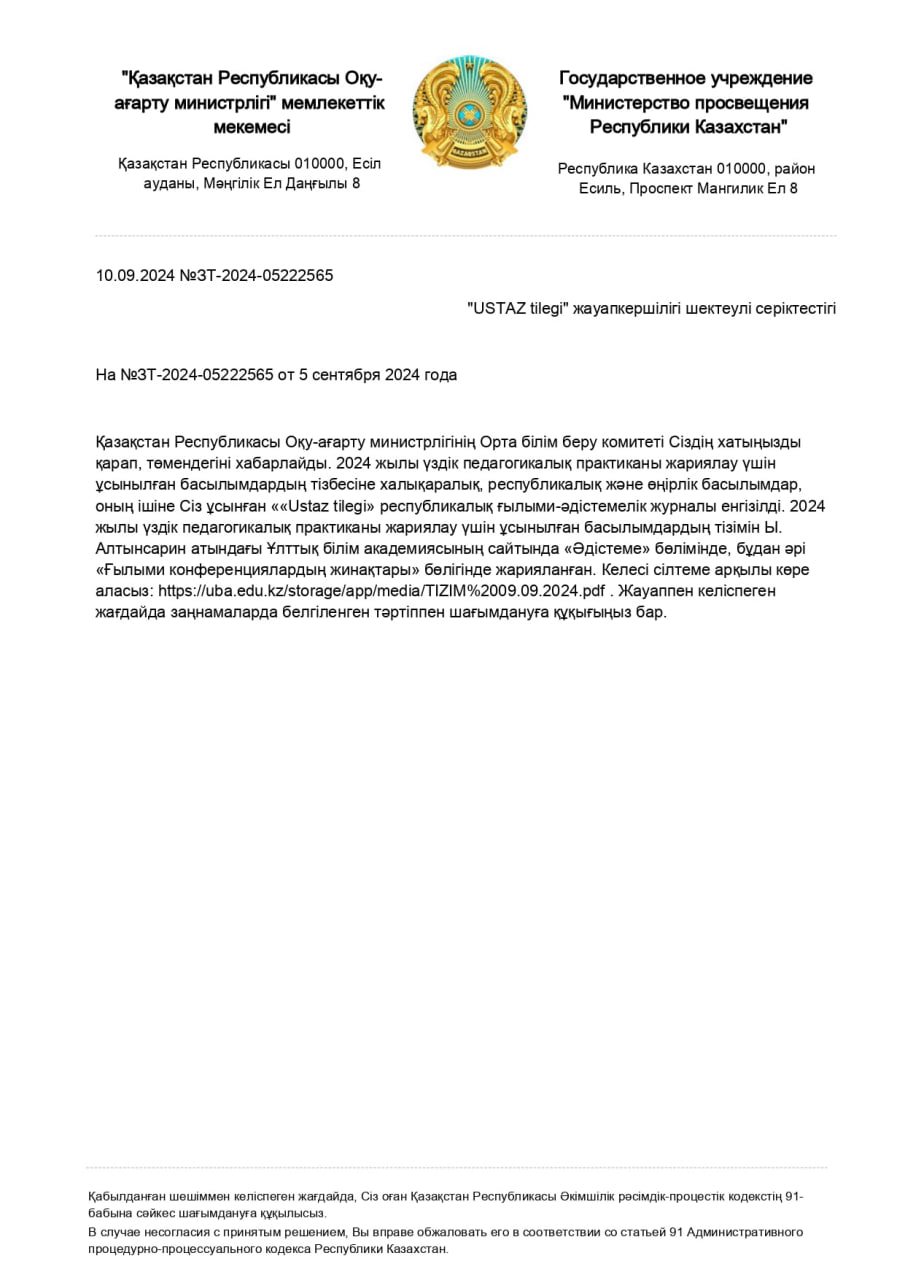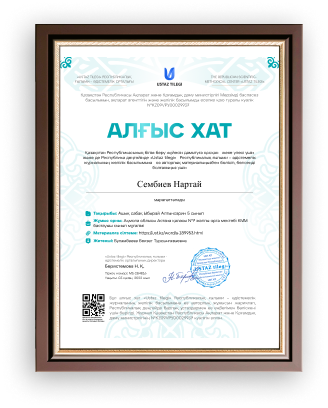
PROBLEMS AND DEVELOPMENT TRENDS IN THE HIGHER EDUCATION SECTOR OF KAZAKHSTAN
Syrlybay A.B., Abdel A.S., Saipilova A.A.
7M01105 Pedagogy. 2nd year master's students of the specialty Educational Management, Department of Pedagogy and Educational Management,
Al-Farabi Kazakh National University
Scientific supervisor: Candidate of Pedagogical Sciences,
Associate Professor Moldasan Kuanysh Shormanovna
Аннотация. Бұл мақалада Қазақстанның жоғары білім беру жүйесіндегі негізгі мәселелер мен даму тенденциялары талданады. Жоғары білім беру сапасының төмендігі, еңбек нарығы мен білім беру арасындағы алшақтық, аймақтық теңсіздік, цифрландыру деңгейінің жеткіліксіздігі және халықаралық интеграцияның әлсіздігі сияқты проблемалар қарастырылады. Сонымен қатар, мақаланың негізгі бөлігінде жоғары білім беру саласындағы оң өзгерістер мен реформаларға назар аударылған. Атап айтқанда, цифрландыру, еңбек нарығына бағдарлану, халықаралық стандарттарға сәйкестендіру, аймақтық университеттерді дамыту және ғылыми-зерттеу әлеуетін арттыру мәселелері қарастырылған. Зерттеу нәтижесінде, жоғары білім беру саласының болашақтағы дамуы үшін жүйелі реформалардың қажеттілігі және жаңа бастамалардың маңыздылығы анықталды.
Тірек сөздер: білім беру жүйесі, даму тенденциялары, реформа, бағдарлама, проблема, стандарт.
Аннотация. В данной статье анализируются основные проблемы и тенденции развития системы высшего образования Казахстана. Рассматриваются такие проблемы, как низкое качество высшего образования, разрыв между рынком труда и образованием, региональное неравенство, недостаточный уровень цифровизации и слабая международная интеграция. Кроме того, основная часть статьи посвящена позитивным изменениям и реформам в сфере высшего образования. В частности, рассмотрены вопросы цифровизации, ориентации на рынок труда, приведения в соответствие с международными стандартами, развития региональных университетов и повышения научно-исследовательского потенциала. В результате исследования была выявлена необходимость системных реформ и важность новых инициатив для будущего развития сферы высшего образования.
Ключевые слова: система образования, тенденции развития, реформа, программа, проблема, стандарт.
Annotation. This article analyzes the main problems and trends in the development of the higher education system in Kazakhstan. Issues such as the low quality of higher education, the gap between the labor market and education, regional inequality, insufficient digitalization and weak international integration are considered. In addition, the main part of the article is devoted to positive changes and reforms in the field of higher education. In particular, the issues of digitalization, orientation to the labor market, alignment with international standards, development of regional universities and improvement of research potential were considered. The study revealed the need for systemic reforms and the importance of new initiatives for the future development of higher education.
Keywords: education system, development trends, reform, program, problem, standard.
The higher education system of Kazakhstan is one of the main pillars of the country's socio-economic and cultural development. Although this sector is developing in line with modern requirements, relevant problems still remain. At the same time, important steps are being taken to improve the quality of education and bring it into line with international standards. Let's dwell on the problems in the higher education sector of Kazakhstan and analyze ways to solve them.
1. Low quality of education
Problem: The low quality of education in Kazakhstan's higher education institutions is one of the main problems. In many universities, curricula are outdated, the professional level of teachers is not always high, and research work is carried out at an insufficient level.
Solutions:
• Updating curricula: Programs need to be adapted to modern requirements, labor market demands, and international standards.
• Teacher training: Organizing regular professional development courses for teachers, introducing foreign experience.
• Strengthening research activities: Providing financial support for research activities of universities, allocating grants and scholarships to young scientists [1].
2. The gap between the labor market and education
Problem: Graduates of higher education institutions often do not meet the requirements of the labor market. There is an oversupply of specialists in some specialties, while there is a shortage in others.
Solutions:
• Development of a dual training system: Establishing close ties between universities and enterprises, ensuring practical experience for students.
• Researching enterprise demand: Regulating the training plans of educational institutions through a regular analysis of labor market needs.
• Career guidance: Creating a special program to guide school students in choosing the right career.
3. Regional inequality
Problem: Regional universities lag behind higher education institutions in large cities in terms of infrastructure, faculty, and funding.
Solutions:
• Support regional universities: Increase funding at the state level, build new campuses and laboratories.
• Attracting mobile teachers: Inviting qualified specialists from large cities or abroad to regional universities.
• Regional grants: Allocating special quotas and grants to young people who want to study in remote regions.
4. Insufficient digitization
Problem: Insufficient use of modern digital technologies hinders the effective organization of the educational process, especially in remote areas.
Solutions:
• Development of digital infrastructure: Providing universities with modern technology and stable access to the Internet.
• Development of e-learning platforms: Improving online learning systems, creating high-quality digital content.
• Training of teachers and students: Introducing special courses on the effective use of digital tools [2].
5. Insufficient funding
Problem: Many universities are unable to implement innovative projects and take the necessary measures to improve the quality of education due to limited financial resources.
Solutions:
• Increase public funding: Increase the share of funds allocated to education and science.
• Attracting the private sector: Establishing partnerships with enterprises and business structures to attract investment in the education sector.
• Expand the grant system: Increase the number of grants for students, master's and doctoral students.
6. Weakness of international integration
Problem: Many universities in Kazakhstan are not internationally recognized and rank low in world rankings.
Solutions:
• Strengthening international partnerships: Developing joint programs with foreign universities, attracting foreign professors.
• Increasing academic mobility: Expanding opportunities for students and faculty to exchange experiences abroad.
• Including universities in rankings: Improving the research potential and quality of education of universities for global recognition.
The higher education system of Kazakhstan plays an important role in the development of the country and increasing its international competitiveness. In recent years, large-scale reforms have been implemented in this area, and new trends have emerged aimed at improving the quality of education. This essay discusses the main trends in the development of the higher education system, including digitalization, international integration, labor market orientation, and the development of regional education systems [3].
Digitization and distance learning. Digitization has become one of the main trends in the higher education system of Kazakhstan. Universities are introducing electronic platforms and digital technologies into the educational process, creating the most favorable conditions for students to study. This process has become especially important during the pandemic. The development of the distance learning system has increased access to education and reduced geographical barriers. In addition, digitization ensures the updating of educational materials and an increase in the quality of teaching. However, in this direction, the issues of infrastructure modernization and Internet access need to be fully resolved.
Alignment with international standards. Kazakhstan's higher education system has moved closer to international standards by joining the Bologna Process. This step has introduced a credit system and ensured the international recognition of Kazakhstani diplomas. In addition, universities are implementing joint programs with foreign partners. Attracting foreign professors, introducing courses in English, and increasing the level of academic mobility are all important measures aimed at raising the quality of education to an international level.
Labor market orientation. Higher education institutions in Kazakhstan are focusing on training personnel in line with labor market demands. By introducing a dual education system, universities are providing students with the opportunity to supplement their theoretical knowledge with practical skills. In addition, partnerships between universities and enterprises are being strengthened. This direction includes the development of new educational programs in promising areas such as the green economy, IT technologies, engineering, and medicine. Such changes will increase the employability of graduates and help meet labor market demands [4].
Development of the regional education system. Support for regional universities is one of the important trends in the field of higher education in Kazakhstan. Efforts are being made to reduce the inequality in the quality of education between regions through the development of educational institutions located in remote regions. The state pays special attention to modernizing the infrastructure of regional universities, training personnel, and strengthening the material base of educational institutions. This will allow young people to receive quality education in their regions and will have a positive impact on the socio-economic development of the regions.
Increasing research potential. Higher education institutions of Kazakhstan are working not only to provide education, but also to develop research services. The state is increasing funding for research projects and trying to turn universities into centers for the development of science and innovation. In this direction, support for young scientists, participation in international research projects, as well as commercialization of research are priorities. Such measures increase scientific potential and contribute to the recognition of higher education institutions at the global level.
Ensuring social accessibility. One of the important directions in the development of the higher education system is to increase access to education. The increase in state grants, quotas for socially vulnerable groups and support programs provide a wide range of people with the opportunity to receive higher education. In addition, the development of an inclusive education system for students with disabilities, the increase in the number of educational institutions equipped with modern equipment are important steps in ensuring social equality.
In addition, we can show the development trends in the field of higher education in Kazakhstan as shown in the following table [5].
1-кесте
|
№ |
Development trends |
Description |
Examples/Actions |
|
1 |
Digital transformation |
Digitalization of educational processes and introduction of distance learning technologies |
Use of online platforms (Platonus, Moodle); Access to electronic libraries |
|
2 |
Dual education |
Facilitating student employment by combining theory and practice |
Cooperation with enterprises; Organization of industrial experience for students |
|
3 |
International cooperation |
Establishing partnerships with foreign universities, developing academic mobility |
“Bolashak” program Double degree programs with foreign universities |
|
4 |
The development of research universities |
Strengthening scientific research and commercializing knowledge |
Nazarbayev University model; Distribution of research grants. |
|
5 |
Developing inclusive education |
Increasing access to education for people with disabilities |
Developing inclusive infrastructure; Expanding opportunities through distance learning |
|
6 |
Education in line with the Sustainable Development Goals |
Incorporating the principles of ecology, social responsibility and sustainable development into the educational process |
Implementation of educational programs in the field of sustainable development. Creation of green campuses; |
|
7 |
Bringing the quality of education into line with international standards |
Focus on international rankings in the educational process |
Strengthening position in QS, THE rankings; introduction of ISO standards. |
|
8 |
Introduction of new technologies and innovations |
The use of artificial intelligence, virtual reality and other modern technologies in education |
Virtual labs Artificial intelligence-based learning |
Conclusion. The higher education system of Kazakhstan is undergoing significant changes to train high-quality personnel and increase its competitiveness at the international level. The current problems require systematic solutions and reforms. Digitalization, labor market orientation, international integration and elimination of regional inequalities are the main directions of higher education. The future of the education system of Kazakhstan depends on the effective solution of these problems and the active implementation of new trends.
List of used literature:
1. B. K. Kuanyshbekov. Problems and development directions in the higher education system. Educational and methodological collection. Almaty: Economy – 2019.
2. M. Zh. Kobetov. Modernization of the higher education system of Kazakhstan: Theory and practice. Almaty: Daur – 2017.
3. E. A. Kosherbayev. Modernization and development trends of the education system in Kazakhstan. Education and Science – 2022. – 28-36p.
4. Sh. B. Aitkazieva. Improving the quality of education in higher education institutions of Kazakhstan. Higher School Journal – 2016.
5. M. S. Suleymenova. (2018). Digitalization in higher education: Kazakhstani experience. Digital Kazakhstan – 2018. – 72-80p.
жүктеу мүмкіндігіне ие боласыз
Бұл материал сайт қолданушысы жариялаған. Материалдың ішінде жазылған барлық ақпаратқа жауапкершілікті жариялаған қолданушы жауап береді. Ұстаз тілегі тек ақпаратты таратуға қолдау көрсетеді. Егер материал сіздің авторлық құқығыңызды бұзған болса немесе басқа да себептермен сайттан өшіру керек деп ойласаңыз осында жазыңыз
PROBLEMS AND DEVELOPMENT TRENDS IN THE HIGHER EDUCATION SECTOR OF KAZAKHSTAN
PROBLEMS AND DEVELOPMENT TRENDS IN THE HIGHER EDUCATION SECTOR OF KAZAKHSTAN
PROBLEMS AND DEVELOPMENT TRENDS IN THE HIGHER EDUCATION SECTOR OF KAZAKHSTAN
Syrlybay A.B., Abdel A.S., Saipilova A.A.
7M01105 Pedagogy. 2nd year master's students of the specialty Educational Management, Department of Pedagogy and Educational Management,
Al-Farabi Kazakh National University
Scientific supervisor: Candidate of Pedagogical Sciences,
Associate Professor Moldasan Kuanysh Shormanovna
Аннотация. Бұл мақалада Қазақстанның жоғары білім беру жүйесіндегі негізгі мәселелер мен даму тенденциялары талданады. Жоғары білім беру сапасының төмендігі, еңбек нарығы мен білім беру арасындағы алшақтық, аймақтық теңсіздік, цифрландыру деңгейінің жеткіліксіздігі және халықаралық интеграцияның әлсіздігі сияқты проблемалар қарастырылады. Сонымен қатар, мақаланың негізгі бөлігінде жоғары білім беру саласындағы оң өзгерістер мен реформаларға назар аударылған. Атап айтқанда, цифрландыру, еңбек нарығына бағдарлану, халықаралық стандарттарға сәйкестендіру, аймақтық университеттерді дамыту және ғылыми-зерттеу әлеуетін арттыру мәселелері қарастырылған. Зерттеу нәтижесінде, жоғары білім беру саласының болашақтағы дамуы үшін жүйелі реформалардың қажеттілігі және жаңа бастамалардың маңыздылығы анықталды.
Тірек сөздер: білім беру жүйесі, даму тенденциялары, реформа, бағдарлама, проблема, стандарт.
Аннотация. В данной статье анализируются основные проблемы и тенденции развития системы высшего образования Казахстана. Рассматриваются такие проблемы, как низкое качество высшего образования, разрыв между рынком труда и образованием, региональное неравенство, недостаточный уровень цифровизации и слабая международная интеграция. Кроме того, основная часть статьи посвящена позитивным изменениям и реформам в сфере высшего образования. В частности, рассмотрены вопросы цифровизации, ориентации на рынок труда, приведения в соответствие с международными стандартами, развития региональных университетов и повышения научно-исследовательского потенциала. В результате исследования была выявлена необходимость системных реформ и важность новых инициатив для будущего развития сферы высшего образования.
Ключевые слова: система образования, тенденции развития, реформа, программа, проблема, стандарт.
Annotation. This article analyzes the main problems and trends in the development of the higher education system in Kazakhstan. Issues such as the low quality of higher education, the gap between the labor market and education, regional inequality, insufficient digitalization and weak international integration are considered. In addition, the main part of the article is devoted to positive changes and reforms in the field of higher education. In particular, the issues of digitalization, orientation to the labor market, alignment with international standards, development of regional universities and improvement of research potential were considered. The study revealed the need for systemic reforms and the importance of new initiatives for the future development of higher education.
Keywords: education system, development trends, reform, program, problem, standard.
The higher education system of Kazakhstan is one of the main pillars of the country's socio-economic and cultural development. Although this sector is developing in line with modern requirements, relevant problems still remain. At the same time, important steps are being taken to improve the quality of education and bring it into line with international standards. Let's dwell on the problems in the higher education sector of Kazakhstan and analyze ways to solve them.
1. Low quality of education
Problem: The low quality of education in Kazakhstan's higher education institutions is one of the main problems. In many universities, curricula are outdated, the professional level of teachers is not always high, and research work is carried out at an insufficient level.
Solutions:
• Updating curricula: Programs need to be adapted to modern requirements, labor market demands, and international standards.
• Teacher training: Organizing regular professional development courses for teachers, introducing foreign experience.
• Strengthening research activities: Providing financial support for research activities of universities, allocating grants and scholarships to young scientists [1].
2. The gap between the labor market and education
Problem: Graduates of higher education institutions often do not meet the requirements of the labor market. There is an oversupply of specialists in some specialties, while there is a shortage in others.
Solutions:
• Development of a dual training system: Establishing close ties between universities and enterprises, ensuring practical experience for students.
• Researching enterprise demand: Regulating the training plans of educational institutions through a regular analysis of labor market needs.
• Career guidance: Creating a special program to guide school students in choosing the right career.
3. Regional inequality
Problem: Regional universities lag behind higher education institutions in large cities in terms of infrastructure, faculty, and funding.
Solutions:
• Support regional universities: Increase funding at the state level, build new campuses and laboratories.
• Attracting mobile teachers: Inviting qualified specialists from large cities or abroad to regional universities.
• Regional grants: Allocating special quotas and grants to young people who want to study in remote regions.
4. Insufficient digitization
Problem: Insufficient use of modern digital technologies hinders the effective organization of the educational process, especially in remote areas.
Solutions:
• Development of digital infrastructure: Providing universities with modern technology and stable access to the Internet.
• Development of e-learning platforms: Improving online learning systems, creating high-quality digital content.
• Training of teachers and students: Introducing special courses on the effective use of digital tools [2].
5. Insufficient funding
Problem: Many universities are unable to implement innovative projects and take the necessary measures to improve the quality of education due to limited financial resources.
Solutions:
• Increase public funding: Increase the share of funds allocated to education and science.
• Attracting the private sector: Establishing partnerships with enterprises and business structures to attract investment in the education sector.
• Expand the grant system: Increase the number of grants for students, master's and doctoral students.
6. Weakness of international integration
Problem: Many universities in Kazakhstan are not internationally recognized and rank low in world rankings.
Solutions:
• Strengthening international partnerships: Developing joint programs with foreign universities, attracting foreign professors.
• Increasing academic mobility: Expanding opportunities for students and faculty to exchange experiences abroad.
• Including universities in rankings: Improving the research potential and quality of education of universities for global recognition.
The higher education system of Kazakhstan plays an important role in the development of the country and increasing its international competitiveness. In recent years, large-scale reforms have been implemented in this area, and new trends have emerged aimed at improving the quality of education. This essay discusses the main trends in the development of the higher education system, including digitalization, international integration, labor market orientation, and the development of regional education systems [3].
Digitization and distance learning. Digitization has become one of the main trends in the higher education system of Kazakhstan. Universities are introducing electronic platforms and digital technologies into the educational process, creating the most favorable conditions for students to study. This process has become especially important during the pandemic. The development of the distance learning system has increased access to education and reduced geographical barriers. In addition, digitization ensures the updating of educational materials and an increase in the quality of teaching. However, in this direction, the issues of infrastructure modernization and Internet access need to be fully resolved.
Alignment with international standards. Kazakhstan's higher education system has moved closer to international standards by joining the Bologna Process. This step has introduced a credit system and ensured the international recognition of Kazakhstani diplomas. In addition, universities are implementing joint programs with foreign partners. Attracting foreign professors, introducing courses in English, and increasing the level of academic mobility are all important measures aimed at raising the quality of education to an international level.
Labor market orientation. Higher education institutions in Kazakhstan are focusing on training personnel in line with labor market demands. By introducing a dual education system, universities are providing students with the opportunity to supplement their theoretical knowledge with practical skills. In addition, partnerships between universities and enterprises are being strengthened. This direction includes the development of new educational programs in promising areas such as the green economy, IT technologies, engineering, and medicine. Such changes will increase the employability of graduates and help meet labor market demands [4].
Development of the regional education system. Support for regional universities is one of the important trends in the field of higher education in Kazakhstan. Efforts are being made to reduce the inequality in the quality of education between regions through the development of educational institutions located in remote regions. The state pays special attention to modernizing the infrastructure of regional universities, training personnel, and strengthening the material base of educational institutions. This will allow young people to receive quality education in their regions and will have a positive impact on the socio-economic development of the regions.
Increasing research potential. Higher education institutions of Kazakhstan are working not only to provide education, but also to develop research services. The state is increasing funding for research projects and trying to turn universities into centers for the development of science and innovation. In this direction, support for young scientists, participation in international research projects, as well as commercialization of research are priorities. Such measures increase scientific potential and contribute to the recognition of higher education institutions at the global level.
Ensuring social accessibility. One of the important directions in the development of the higher education system is to increase access to education. The increase in state grants, quotas for socially vulnerable groups and support programs provide a wide range of people with the opportunity to receive higher education. In addition, the development of an inclusive education system for students with disabilities, the increase in the number of educational institutions equipped with modern equipment are important steps in ensuring social equality.
In addition, we can show the development trends in the field of higher education in Kazakhstan as shown in the following table [5].
1-кесте
|
№ |
Development trends |
Description |
Examples/Actions |
|
1 |
Digital transformation |
Digitalization of educational processes and introduction of distance learning technologies |
Use of online platforms (Platonus, Moodle); Access to electronic libraries |
|
2 |
Dual education |
Facilitating student employment by combining theory and practice |
Cooperation with enterprises; Organization of industrial experience for students |
|
3 |
International cooperation |
Establishing partnerships with foreign universities, developing academic mobility |
“Bolashak” program Double degree programs with foreign universities |
|
4 |
The development of research universities |
Strengthening scientific research and commercializing knowledge |
Nazarbayev University model; Distribution of research grants. |
|
5 |
Developing inclusive education |
Increasing access to education for people with disabilities |
Developing inclusive infrastructure; Expanding opportunities through distance learning |
|
6 |
Education in line with the Sustainable Development Goals |
Incorporating the principles of ecology, social responsibility and sustainable development into the educational process |
Implementation of educational programs in the field of sustainable development. Creation of green campuses; |
|
7 |
Bringing the quality of education into line with international standards |
Focus on international rankings in the educational process |
Strengthening position in QS, THE rankings; introduction of ISO standards. |
|
8 |
Introduction of new technologies and innovations |
The use of artificial intelligence, virtual reality and other modern technologies in education |
Virtual labs Artificial intelligence-based learning |
Conclusion. The higher education system of Kazakhstan is undergoing significant changes to train high-quality personnel and increase its competitiveness at the international level. The current problems require systematic solutions and reforms. Digitalization, labor market orientation, international integration and elimination of regional inequalities are the main directions of higher education. The future of the education system of Kazakhstan depends on the effective solution of these problems and the active implementation of new trends.
List of used literature:
1. B. K. Kuanyshbekov. Problems and development directions in the higher education system. Educational and methodological collection. Almaty: Economy – 2019.
2. M. Zh. Kobetov. Modernization of the higher education system of Kazakhstan: Theory and practice. Almaty: Daur – 2017.
3. E. A. Kosherbayev. Modernization and development trends of the education system in Kazakhstan. Education and Science – 2022. – 28-36p.
4. Sh. B. Aitkazieva. Improving the quality of education in higher education institutions of Kazakhstan. Higher School Journal – 2016.
5. M. S. Suleymenova. (2018). Digitalization in higher education: Kazakhstani experience. Digital Kazakhstan – 2018. – 72-80p.

шағым қалдыра аласыз















